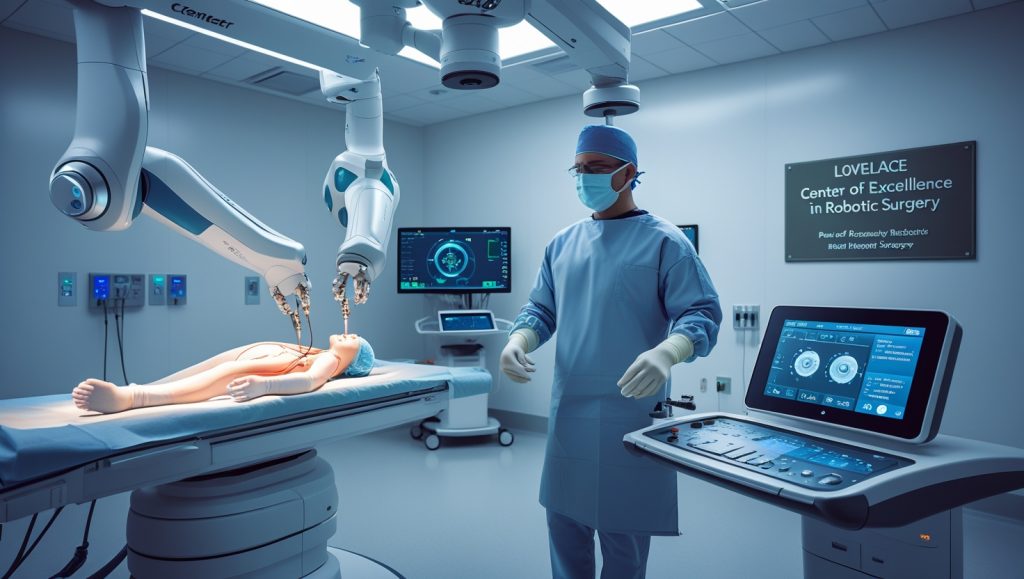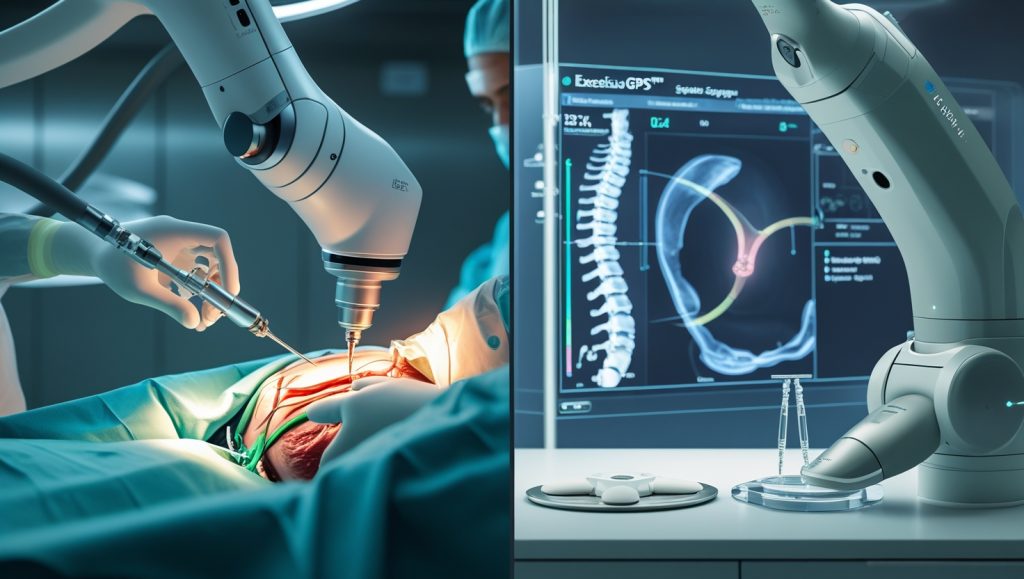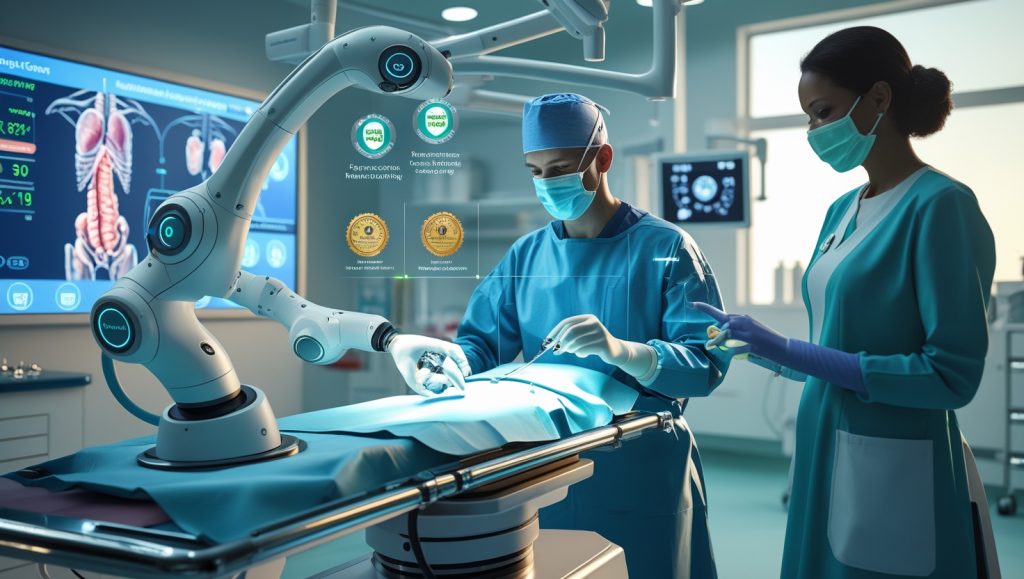What does a sixth surgical robot mean for patient care in 2025? For Lovelace Hospital, the answer lies in a transformative blend of precision, efficiency, and community trust. In May 2025, the Albuquerque-based institution expanded its robotic fleet with a da Vinci 5® system, marking its sixth surgical robot and reinforcing its leadership in minimally invasive care. This milestone transcends technological novelty—it addresses a pressing need for safer, faster, and more accessible surgeries, showcasing robotic surgery benefits in action.
This article unpacks how Lovelace’s investment aligns with broader healthcare trends, from reducing postoperative pain to training the next generation of surgeons. Through patient stories, surgeon insights, and data-driven analysis, we reveal why robotic surgery benefits are reshaping modern medicine. For a deeper look into how advanced robotics is transforming healthcare, explore the future of robotic surgery and its bold predictions for 2030.
1. The Strategic Evolution of Robotic Surgery at Lovelace

Lovelace’s robotic program began in 2011 with its first da Vinci system, focusing on gynecological and general surgeries. Over 14 years, the program has grown into a nationally recognized hub, performing over 11,000 robotic procedures since 2024. The addition of the sixth robot—a da Vinci 5® with tactile feedback—positions Lovelace as New Mexico’s largest provider of robotic-assisted surgeries, amplifying robotic surgery benefits.
Key Drivers of Growth:
- Patient Demand: Shorter recovery times (40% of hernia patients discharged same-day) and reduced scarring (incisions as small as 1–2 cm) have fueled adoption, highlighting robotic surgery benefits for patients seeking minimally invasive options.
- Surgeon Expertise: Dr. Mario Leyba, among the top 1% of U.S. surgeons by volume, has completed 4,000 robotic cases, including the hospital’s 9,000th robotic procedure in 2022.
- Accreditation: Lovelace Women’s Hospital earned the state’s first Center of Excellence in Robotic Surgery (COERS) designation in 2017, a testament to rigorous safety standards.
For insights into how robotics training is shaping future surgeons, check out why STEM robotics competitions are fueling innovation.
2. Robotic Surgery Benefits: Quantifying Patient Outcomes
The da Vinci 5®’s tactile feedback and 3D imaging address historic limitations, allowing surgeons to “feel” tissue tension while operating through sub-centimeter incisions. These advancements translate to measurable robotic surgery benefits:
- 20% Faster Procedures: Complex surgeries, such as hernia repairs, now take hours instead of days, enabling surgeons to treat an additional patient daily.
- Reduced Complications: Data shows a 30% lower risk of infection compared to open surgery, attributed to smaller incisions and enhanced precision.
- Economic Impact: Shorter hospital stays cut costs for patients and insurers. For example, robotic hip surgeries at Lovelace Regional Hospital reduced average stays by 2 days using Stryker’s Mako SmartRobotics™.
Surgeon Perspective:
Dr. Michael Blea, a Lovelace robotic surgeon, emphasizes, “The robot isn’t replacing us—it’s amplifying our skills. Smaller instruments mean we can operate in confined spaces without compromising accuracy.” For a broader perspective on why robotic surgeons still can’t fully replace humans, see why robot surgeons can’t replace humans yet.
3. Case Studies: Where Robotics Outperforms Traditional Methods

Hernia Repairs: Precision That Redefines Recovery
Traditional hernia surgeries often require large incisions, increasing infection risks and recovery times. Lovelace’s robotic approach minimizes invasiveness, delivering clear robotic surgery benefits:
- Dr. Blea uses the robot’s wristed instruments to navigate tight abdominal spaces, reducing incision sizes by 60%.
- Patients like John Robledo (name changed for privacy) returned to work within days, a stark contrast to weeks-long recoveries with open surgery.
This precision aligns with broader trends in robotics, such as soft robotics and artificial muscles that enhance surgical dexterity.
Spine Surgery: Robotics Meets Advanced Navigation for Superior Outcomes
In 2018, Lovelace became New Mexico’s sole provider of ExcelsiusGPS™ robotic spine surgery, slashing blood loss and radiation exposure by 45%. The system’s CT-guided navigation ensures sub-millimeter accuracy, critical for spinal implant placements, further demonstrating robotic surgery benefits in complex procedures. For more on how robotics is revolutionizing precision, explore BMW’s humanoid robot precision manufacturing.
4. Training and Community Engagement: Building Trust in Technology
Robotic surgery’s success hinges on surgeon expertise. Lovelace mandates 200+ hours of simulation training, blending gamification techniques (e.g., leveraging hand-eye coordination from video games) with real-world scenarios, ensuring surgeons maximize robotic surgery benefits.
Community Initiatives:
- Wall-e the Robot: A first-grade class at Bel-Air Elementary named the sixth robot, fostering STEM interest. Dr. Blea notes, “Inspiring future innovators is as vital as the technology itself.” Learn more about robotics inspiring youth in 2025’s VEX IQ Robotics Competition.
- Live Surgical Broadcasts: Surgeons globally watch Lovelace’s live-streamed procedures, such as Dr. Leyba’s gallbladder surgery viewed by 1,000+ professionals in Nashville.
5. Future Directions: AI, Remote Surgeries, and Beyond
Lovelace’s roadmap includes:
- AI Integration: Predictive analytics to anticipate complications pre-surgery (slated for 2026 trials). For more on AI’s role in healthcare, see how AI-driven scientific discovery is transforming research.
- 5G-Enabled Telesurgery: Partnering with rural hospitals like Lovelace Regional in Roswell to perform remote joint replacements, expanding access to robotic surgery benefits.
- Orthopedic Expansion: A $1M Mako SmartRobotics™ system at Lovelace Regional Hospital is already cutting recovery times for knee and hip replacements.
For a glimpse into how AI is shaping surgical futures, check out why explainable AI is critical for trustworthy tech.
6. Addressing Common Concerns: Safety, Cost, and Accessibility

Why Safety Remains a Cornerstone of Robotic Surgery
Robotic surgery’s safety profile is well-established, with complication rates 30% lower than open methods. Lovelace’s COERS certification underscores adherence to global safety benchmarks, ensuring robotic surgery benefits are delivered responsibly.
Why Cost Doesn’t Outweigh the Value of Robotic Surgery
While robotic systems cost millions upfront, insurers typically cover procedures. Reduced hospital stays offset expenses—e.g., same-day discharges save $3,000–$5,000 per patient, a key robotic surgery benefit for affordability. For more on cost democratization in tech, see AI cost democratization in 2025.
Why Accessibility Is Expanding Through Strategic Partnerships
Lovelace addresses rural disparities through partnerships. For instance, Roswell residents now access Mako SmartRobotics™ without traveling to Albuquerque, broadening the reach of robotic surgery benefits. Learn about global efforts to enhance accessibility in Switzerland’s autonomous delivery robots.
Final Verdict
Lovelace Hospital’s sixth surgical robot exemplifies a healthcare ethos where technology serves humanity. By merging surgeon expertise with robotic precision, the institution sets a benchmark for patient-centric innovation. As Dr. Leyba states, “Our tools evolve, but our mission remains: to heal faster, safer, and with unwavering compassion.” For a broader look at robotics in healthcare, explore why robotics is a secret weapon against climate change.
FAQ Section
How does robotic surgery reduce recovery time?
Smaller incisions minimize tissue damage, allowing 40% of hernia patients to return home the same day.
Are robotic surgeries covered by insurance?
Most plans cover these procedures, and shorter hospital stays often lower overall costs.
Can any surgeon operate these robots?
No—surgeons require 200+ hours of specialized training and Master Surgeon certification.
What’s next for Lovelace’s robotic program?
Plans include AI-driven predictive analytics and 5G-enabled remote surgeries by 2026.
Your Next Step?
Stay updated on robotic advancements! Subscribe to our newsletter or explore other surgical services blog for the latest innovations in robotic surgery benefits.



